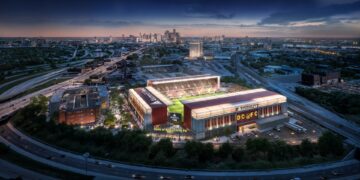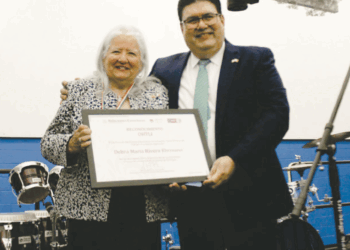For over 100 years the Detroit River was perceived as a working waterway that supported industry and commerce. As such, its shoreline was progressively hardened with concrete seawalls, steel sheet piling, or re-purposed broken concrete. This stabilized the shoreline, helped protect against erosion, and allowed for safe industrial and commercial development.

But it came at a steep price. Shoreline hardening is use of concrete seawalls and steel sheet piling to stabilize the shoreline, but provides no habitat for the fish, wildlife, plants, and invertebrate species who call the river home.
Fast forward to today: the Detroit Riverfront Conservancy is now a leader in softening the shoreline by using ecological principles and practices to achieve stabilization and safety while enhancing habitat and improving aesthetics.
Curious to know more, I spent a recent late summer morning navigating a boat down the river to see the shoreline firsthand. The starting point for this riverine tour was Bayview Yacht Club on Conner’s Creek which flows into the upper Detroit River. The first thing I noticed was the steel-hardened shoreline of Conner’s Creek. But soon I arrived at the confluence with the Detroit River and was greeted with the stark contrast of the natural beauty of Lake St. Clair, Windsor’s uninhabited Peche Isle, and Detroit’s 980-acre island park called Belle Isle that is visited by more than five million Detroiters and others each year.
It was a beautiful summer morning, and the weather was ideal – fair and calm. The water’s surface was like a mirror reflecting distant images of the islands and waters, reminiscent of Vincent Van Gogh or Claude Monet’s water-themed paintings.
Upon entering the Detroit River, I headed west and downstream toward downtown Detroit. Because it was early morning it was relatively quiet, with only the “kree, kree” sounds of a few ringed-billed gulls, the clanging of some sailboat cables, and the low-pitched hum of the boat motor.
It was so incredibly peaceful and truly captured the beauty of the Detroit River. But as I continued my journey downstream, it was obvious that I was in a major urban area with a long history of waterfront commerce and industry. Mile after mile I passed hardened shorelines made of concrete seawalls, steel sheet piling, or repurposed broken concrete with rebar protruding in many directions.
I could not help but think about the shoreline from a fish and wildlife perspective. Where do they feed and rest? What happened to the wetlands and spawning and nursery grounds of fishes? Where along these hardened shorelines can invertebrates live? What have humans done to the place they call home?
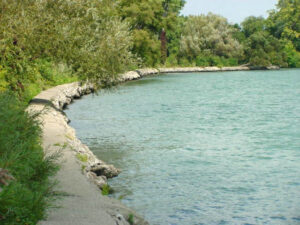

About 25 years ago, natural resource managers and scientists started recognizing the critical importance of getting habitat champions involved up-front in waterfront redevelopment projects to incorporate principles of soft shorelines – using rocks and plants to stabilize the shoreline, reduce erosion, enhance habitat, and improve aesthetics, into future designs. Experience showed that if habitat champions were not at the table when key waterfront decisions were made, the standard practice would be to harden shorelines with seawalls or steel sheet piling. Historically, re-purposed broken concrete with protruding rebar was also a standard shoreline practice that was not ideal for habitat nor aesthetically pleasing. Today, natural limestone rock of varying sizes, called rip rap, with interspersed plants is a type of soft shoreline that is better for habitat and much more aesthetically pleasing.
For the last 20 years, the Detroit Riverfront Conservancy has championed soft shorelines in creating the city’s new waterfront porch called the Detroit RiverWalk. Thus far, eight soft shoreline projects have been incorporated into the RiverWalk, including the newest section under construction called the Ralph C. Wilson, Jr. Centennial Park – which promises to be the best yet from a habitat perspective.
As I approached Wilson Park, I slowed the speed of my boat to get a better look at the work underway. This new park has been described as transformational for Southwest Detroit and beyond. When it opens in 2025, it will surely be a place where memories are made. It will feature two regulation-size basketball courts in an outdoor sport house, a playground with multiple animal structures, an expansive lawn for outdoor events, and a water garden.

Wilson Park is located next to a contaminated sediment hotspot in the river. That means the project began with the placement of an “environmental cap” of clean sand over the contaminated sediments so that toxic substances would not contribute to cancerous tumors in fish or be toxic to other aquatic life. This cap can best be described as a long narrow band that extends along 2,100 feet of shoreline and covers approximately three acres of bottom sediments.
Next, a stone revetment was placed on top of the cap and along the shoreline to absorb and dissipate the energy of waves. This protects the shoreline and park from erosion and safeguards the cap.

Wilson Park has been designed to provide habitats for a healthy ecosystem. Its centerpiece is the nearly two-and-a-half-acre water garden, which to my eye looks like a lobe-shaped amoeba with lots of bends to enhance habitats and increase its aesthetic appeal.
“The purpose of the water garden is to create habitat, provide an opportunity for park visitors to interact with nature, promote conservation, and foster environmental education,” said Nate Trevethan, lead architect on the project from the world-renowned architectural firm of Michael Van Valkenburgh Associates.
Water from the Detroit River will be pumped into the water garden through a pipe, and a low dam-like structure across the outlet to the river, called a weir, will maintain the desired water area and depth. This water garden is a form of wetlands often called “nurseries of life” because they support thousands of species. The Detroit River has lost 97% of its coastal wetlands to commercial and industrial development so Wilson Park will represent a net gain in these rare habitats.
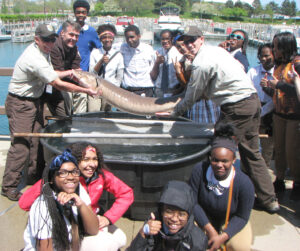
Along the Wilson Park shoreline will be a variety of habitats, including more than 20 triangular wooden habitat structures that will create cover and resting areas for fish. In addition, 12 hollow, semicircular concrete structures called reef balls will enhance habitat for fish and invertebrates. The strategic placement of stone will also create three eddies to change the water’s speed and create backwater habitat and resting spaces for fish. Just offshore from the riverside habitat rehabilitation will be a 50 by 150-foot fish spawning reef for rock-loving spawners like walleye, smallmouth bass, and lake sturgeon.
Along the riverbanks and around the water garden will be plenty of native aquatic plants like sedges and arrowheads. In addition, substantial numbers of native trees, herbaceous perennials and shrubs, and wildflowers will be planted around the water garden and throughout the park.
This site was once a railyard, then a printing facility, and then an industrial brownfield – land that was abandoned or underused due to pollution from industry. “The project is a dramatic contrast with what was there before – an industrial brownfield with a failing seawall,” said Trevethan. “We had to work within the site constraints like fast river currents and winter ice erosion, but our goal was to provide as much habitat as possible.”
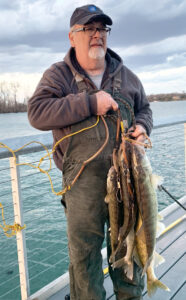
As I turned the boat around to head back upriver to Bayview Yacht Club, I was impressed with the habitat restoration going on in Wilson Park. I also felt a sense of hope – if such habitat restoration can be achieved at Wilson Park, it can be achieved elsewhere.
John Hartig is a board member at the Detroit Riverfront Conservancy. He serves as a Visiting Scholar at the University of Windsor’s Great Lakes Institute for Environmental Research and has written numerous books and publications on the environment and the Great Lakes. Hartig also helped create the Detroit River International Wildlife Refuge, where he worked for 14 years as the refuge manager.
This story was first published on Detroit Public Television’s Great Lakes Now, a monthly news site that offers in-depth coverage of Great Lakes news, issues, events, and developments.

















